F/Lt COLIN J. ELLIS
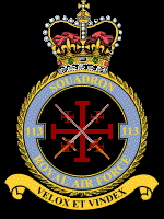
RAF 113 SQUADRON
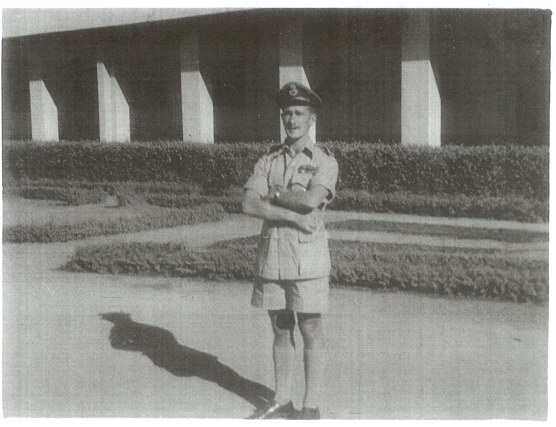
F/Lt Colin J Ellis, Born 18 September 1923 London England. Commissioned Officer RAF 1942 to 1946. Pilot Hurricanes, Spitfires and Thunderbolts. Served Palestine, India, Burma, England.
PART 1 - TRAINING & EARLY POSTINGS
15 days after war with Germany was declared on 3 September 1939 I had my 16th Birthday.
July 1940 joined the Home Guard based at Chigwell in Essex.
January 1942 volunteered for Aircrew at Romford Essex recruiting office.
February 1942 sent to Oxford for a 3 day assessment for intelligence and medical tests. Accepted and placed on deferred service. Directed to join the local Air Training Corps at Woodford Essex.
September 1942 received call up papers and reported to Air Crew Receiving Centre (ACRC) at St Johns Wood London on 28 September for 3 weeks induction, kitting out etc. Then 3 weeks at Ludlow Camp, followed by another 3 weeks back at ACRC. After embarkation leave, was posted to Blackpool where we were issued with tropical kit. In early December embarked on Troopship RMS Rangitiki and after a 4 week voyage arrived at Durban, SouthAfrica. Finally, onto a troop train for a 2 1/2 day ride to Bulawayo in Southern Rhodesia for training under the Empire Aircrew Training Scheme. Then followed:
-16 weeks at ITW Bulawayo for basic ground work.
-16 weeks at EFTS for elimentary Flying Training on de Havilland Tiger Moths at Guinea Fowl
-16 weeks at SFTS for service Flying Training on North American Harvards at Thornhill.
On 17 December 1943 was awarded my Flying Badge and a Commission as a Pilot Officer.
Retained at Thornhill as a Staff Pilot for training as an instructor, but persuaded the CFI that I
should move on.
At the end of February was posted to the Middle East and travelled north overland by train, bus, Iorry and lake steamer ending up at Kisumu in Kenya. From Kisumu the final leg to Cairo was by Loadstar with a night stop at Juba in the Sudan.
In April 43 was posted to No.74 OTU at Petah Tiqva in Palestine for Tac/R training flying PRU Hurricanes and Spitfire Vs. On completing the course was posted to 22 PTC in Cairo. Normally, pilots from 74 0TU were sent to the Italian Theatre, but 4, F/Lt Stinger, PO's Proud, Monro and myself were posted to India as urgent replacements for 28 Squadron operating in Burma. On10 June we were flown by Imperial Airways Ensign from Cairo to Karachi nightstopping at Basra.
In true Service fashion no-one in India had any knowledge of our urgent posting so we spent several weeks in transit camps at Karachi and Bombay. In early August we were posted to No.3 RFU at Poona for a refresher course flying Harvards and Hurricanes. From Poona we went to the Low Attack Instruction School (SLAIS) for a course on Hurribombers. On completion the 4 (still together) were posted to Imphal in the Indian State of Manipur, travelling overland via Calcutta and Kohima. At Group Headquarters F/O Munro was posted to 11 Squadron and F/O Slinger, F/O Proud and myself to 113 Squadron.
PART 2 - Posting 113 Squadron.
At the time of our arrival at Palel, Sq/Ld Buck Courtney, having been posted to Group HQ, was handing command of the Squadron to Australian F/Lt Frost. The Pilots were a commonwealth mix of Canadians, Australians, New Zealanders and the rest from UK. As it was a close support Squadron, Major Teddy Kennington was attached to us to brief on Army targets. After local familiarisation flights I flew on my first operationaI sortie on 8 october 44 to bomb and straff bunker positions north of Tiddim. From then onwards it was close support for the Army carrying out 2 to 3 sorties a day - when on duty.
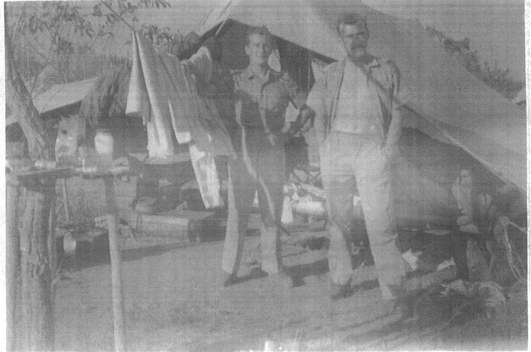
In Burma we lived in tents or grass bashers, this photo is typical of the situation and
shows F/O Alan Proud on right and myself (F/O Colin Ellis) on the left.
SOURCE COPYRIGHT ALL PHOTOS: Colin Ellis
On 20 November we were briefed to attack INGON, a village east of the Chindwin River, a Japanese base for troops and stores. Approaching Kalewa, we were now over Japanese occupied territory, 'A' Flight Commander ordered the change from Flight formation to line-astern. Nearing completion of the manoeuvre there was an almighty thump behind and the controls went comptetely stack, in fact my tail-ptane had disappeared. After some effort I managed to bale out and landed in the trees of jungle covered razor back hills. My aircraft had crashed and exploded a short distance away. l smartly left the area not knowing if the Japs were about and after a time stopped to check my kit. At the time of briefing back at base, I went to my locker and found that my parachute had been removed for routine repacking, so I borrowed the nearest chute. I was 5'6" tall and the pilot whose parachute I had borrowed must have been over 6'0". Consquently, when I baled out and pulled the rip cord, the shoulder straps fell off and I decended head first. My feet fortunately caught in the lower straps. Being upside down, I watched several items fall away including my escape pouch containing money, maps etc. Using the escape kit issued to all pilots, I planned a route across the range of hills, avoiding paths etc, and after 5 days walking reached the lines of our advancing troops. It was only when the Army Intelligence Officer who debriefed me mentioned that they had been asked to look out for 2 pilots, that the realisation came that a mid-air collision probably resulted in the crash. When I returned to Palel I learned that WO Lofty Ball was the other pilot and to my knowledge the crash site has never been found.
I was sent off to India on survivors leave which should have been for two weeks, destination Puri on the east coast. However, I did not return to the Squadron, now stationed at Onbauk in central Burma until 23 January 45. Before going on leave I had asked the Squadron Doc whether I should continue to take mepacrine, the anti-malarial tablets. He said no, as Puri was not in a malarial area. After 10 days I had a severe attack of malaria and spent Christmas and the New Year in an Army hospital!
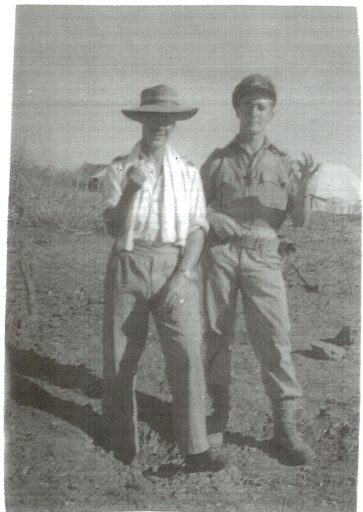 F/Lt Stan Chilton on left, and F/O Colin Ellis on right side of photo, taken at Enbauk 1945. They are displaying bits of shrapnel. During the night, the Japs raided the airstrip and dropped fragmentation bombs. The following morning the Station Commander instructed all the pilots of 34, 113, 152, and 155 Squadrons to form a line and walk the length of the airstrip picking up splinters to avoid our tyres being punctured. Pilots were classified as GD (General Duties) so it was appropriate they should be assigned mundane jobs.
F/Lt Stan Chilton on left, and F/O Colin Ellis on right side of photo, taken at Enbauk 1945. They are displaying bits of shrapnel. During the night, the Japs raided the airstrip and dropped fragmentation bombs. The following morning the Station Commander instructed all the pilots of 34, 113, 152, and 155 Squadrons to form a line and walk the length of the airstrip picking up splinters to avoid our tyres being punctured. Pilots were classified as GD (General Duties) so it was appropriate they should be assigned mundane jobs.The Squadron moved from Onbauk to Ondaw, then to Kwetne where we carried out the last Hurribomber strikes before converting to P47 Thunderbolts. My last Hurricane operation was on 4 April 1945 to B/S bunker positions in the village of legyi.
The conversion to Thunderboits was quite exciting. Exchanging a snug Hurricane cockpit for the huge glasshouse of the Thunderbolt was an experience, one could almost get up and walk around. Being the last Hurricane Squadron to convert, we were allocated the clapped out Mk1 T/Bolts used by the previous converting squadrons, but they were soon replaced by the Mk2 with the bubble canopies. Most things bad doubled up - the Hurricane had 4 2Omm cannon and carried two 25OLb bombs whilst the T/Bolt had 8 - .5 guns and carried two 5OOIb bombs, the Range of the T/BoIt was also double that of the Hurricane. One advantage the Hurricane had over its replacement was that it could take off and land on short 1000yd strips whereas the big boy really needed longer ones. The conversion took place at Wangjing in the Imphal valley.
As the Army rapidly advanced the Squadron moved stations, Kwetne to Myingyan, Kynmagon, then to Meiktila, continuing the close co-operation with the Army. During this time the Monsoon was in full swing making operations very dicey.
My last operational sortie against the Japanese was on 3 August 45 to B/S the village of Shangyaung - then THE BOMB was dropped.
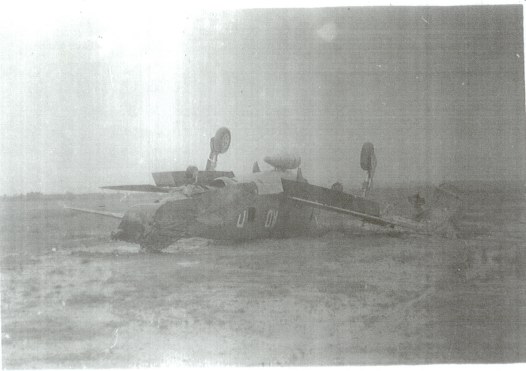 On 18 August 45 the Squadron moved from Meiktila to Zayatkwin just north of Rangoon where I succeeded in overturning my Thunderbolt on landing. The strip was made of bit-hess (similar to roofing felt). To help drainage, ditches had been dug at right angles to the strip. Our arrival coincided with a heavy downpour and we were instructed by the Station Commander to land downwind so that we could taxi straight into the new dispersal area. The wind was actually coming from over the left shoulder and after touchdown on the threshold I drifted to the right and halfway down the runway ran onto the mud, hitting the first ditch at some speed - result, on my back. Fortunately the aircraft did not catch fire and it took those on the ground over half an hour to dig me out as the cockpit was flush with the ground, the fin and rudder having folded over.
On 18 August 45 the Squadron moved from Meiktila to Zayatkwin just north of Rangoon where I succeeded in overturning my Thunderbolt on landing. The strip was made of bit-hess (similar to roofing felt). To help drainage, ditches had been dug at right angles to the strip. Our arrival coincided with a heavy downpour and we were instructed by the Station Commander to land downwind so that we could taxi straight into the new dispersal area. The wind was actually coming from over the left shoulder and after touchdown on the threshold I drifted to the right and halfway down the runway ran onto the mud, hitting the first ditch at some speed - result, on my back. Fortunately the aircraft did not catch fire and it took those on the ground over half an hour to dig me out as the cockpit was flush with the ground, the fin and rudder having folded over.From Zayatkwin we carried out several sorties dropping nichol bombs (pamphlets) on Kyauki and Tavoy etc. mainly to tell the many Japanese stranded in the jungle that the war was over! My last flight in a Thunderbolt was on 4 September 45, an abortive recce of POW camps west of Bangkok.
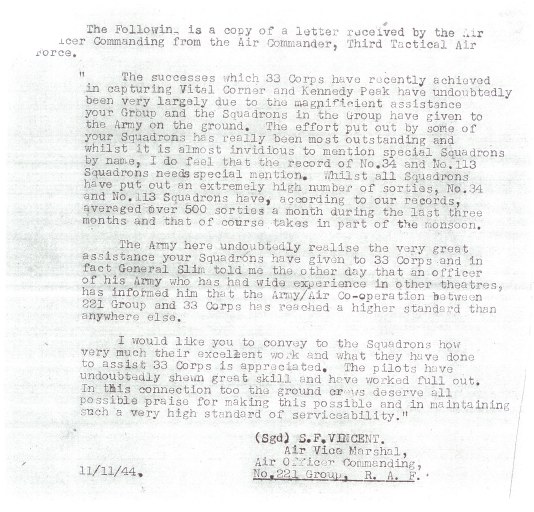
The 113 This "Strawberry" dated 11/11/1944 speaks for itself and gives quite a glow of satisfaction.
The 113 Squadron and 34 Squadron invariably moved together from strip to strip and we shared
many things including post war reunions.
PART 3 - POST WAR
After 113 was disbanded, those with Spitfire experience were posted to No.3 RFU Bhopal where we had a refresher course on fighter and fighter bomber tactics, flying Spitfire MkV111's. On completion I was posted, together with F/Lt Slinger and F/O Proud to OCTS Poona. In February 46, again with F/O Alan Proud, I was posted to 155 Squadron based at Medan in Sumatra flying Spitfire Mk V111's. It was like joining old friends because 155 were based at Palel when we joined 113 in September 44. Sumatra was largely controlled by Indonesian Nationalists and our tasks were to reconnoitre for road blocks etc - the locals were not friendly. Ironically, the Japanese army, under British control, was keeping order in many parts of the country.
My UK posting came through and I left 155 Squadron on 27 April and at Singapore embarked on RMS Carthage for Southampton arriving in mid June, having been away for 3 1/2 years.
At the time of being awarded my Wings and Commission in December 43, I had formally proposed by letter from Rhodesia to Monica, my girlfriend; so upon return, arrangements were made for our wedding which took place on 24 August 1946. We have a trunk full of letters exchanged during those 3 1/2 years!
Finally, my last posting was as OC Special Duties List in London, by then a Flight Lieutenant. Being a Londoner I was able to live at home and travelled each day to the West End. Then came demob on October 46 - back to civvy street.
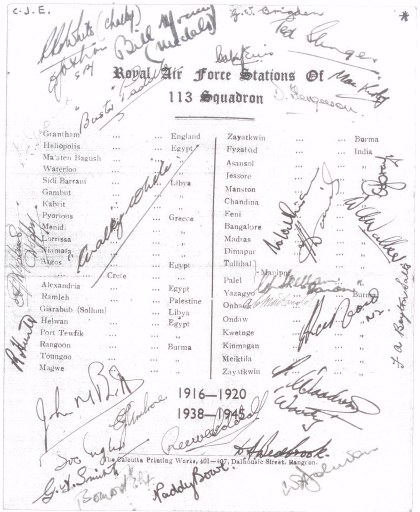
Back cover of Farwell Booklet issued to the squadron at their last dinner together
prior to the squadrons disbandment in 1945. Some of those names which can be read are Paddy Bowe, G. Smith, F.A. Boyton Salts, Graham Skellam, R Hunte (Hunt?), Hopkins - Hoppy, Ted Slinger, Gerrard Brigden, Mac Kirby, Buster Paddle, Alan Proud, and many others which can not be postively made out.
SOURCE: F/Lt Colin J Ellis, May 2006
BACK TO F/Lt Colin J Ellis main Listing main listing personnel section
